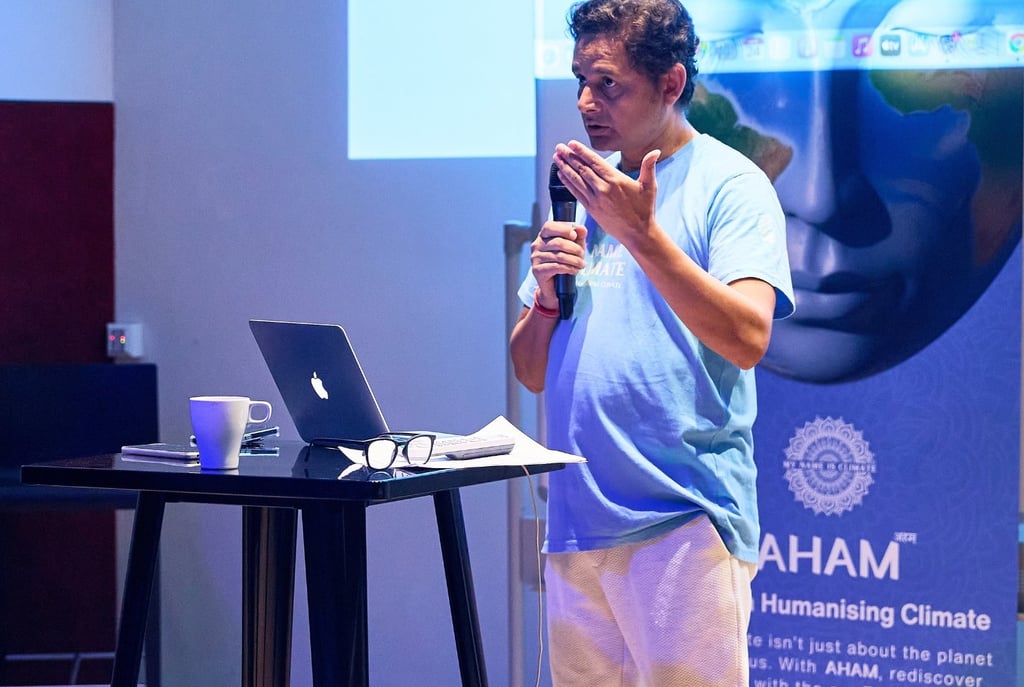
Aham Session: Reconnecting Humanity with Nature in a Modern World
The Aham Session is a transformative experience designed to restore humanity’s bond with nature, drawing from ancient indigenous wisdom and modern ecological awareness. Suitable for all ages and group sizes.
CLIMATE ACTION
Lalit Bhusal
8/13/20254 min read



The Aham Session is a transformative experience designed to restore humanity’s bond with nature, drawing from ancient indigenous wisdom and modern ecological awareness. Suitable for all ages and group sizes.
Introduction: The Disconnection from Nature
In an era dominated by urbanisation and digital immersion, humanity has gradually lost the intrinsic connection to nature that once defined our existence. While technological advancements have brought convenience, they have also distanced us from the natural world—the very foundation of life. The Aham Session emerges as a bridge between modern living and ancestral wisdom, offering a pathway to rediscover our place within the Earth’s ecosystem.
Understanding the Aham Session
Derived from the Sanskrit term Aham, meaning "I" or "self," the Aham Session is rooted in the philosophy that true ecological awareness begins with self-awareness. Recognising that human beings are composed of the same five elements—earth, water, fire, air, and space—as the natural world fosters a deeper sense of kinship with the environment.
This session is not a revival of any single tradition but a synthesis of indigenous practices from cultures worldwide that honour nature as sacred. By reframing the Earth, climate, and natural systems as living entities, the Aham Session cultivates a mindset of reciprocity and stewardship.



Core Objectives of the Aham Session
Reawakening Ecological Consciousness: Encouraging participants to perceive nature not as a resource but as a living, interconnected system.
Humanising the Climate: Shifting abstract climate discourse into a personal, emotional connection with the planet.
Inspiring Action: Motivating individuals and communities to adopt sustainable practices in daily life.
Session Structure and Accessibility
The Aham Session is designed to be inclusive and adaptable, making it suitable for diverse audiences:
Participants
Age Groups: From children (5+) to adults and seniors.
Group Sizes: Flexible for intimate gatherings (5-10 people) or large-scale events (up to 500 attendees).
Organisations: Schools, universities, corporations, government agencies, and community groups.
Logistical Requirements
Duration: 45 to 60 minutes.
Technical Needs: A functional sound system with speakers and a microphone for the facilitator.
Ambience: Specially composed Aham music enhances the meditative and reflective aspects of the session.
Booking and Inquiries:
For session bookings or further details, please contact us via email at hi@mynameisclimate.com.
The Philosophical Foundation: Learning from Indigenous Wisdom
The My Name is Climate Foundation, creator of the Aham Session, operates on the principle of "humanising climate"—transforming environmental awareness from a distant concern into a personal, emotional bond. This philosophy is deeply informed by indigenous cultures that have maintained sustainable relationships with nature for millennia.
Global Indigenous Inspirations
The Aham Session integrates teachings from various indigenous traditions, including:
1. Sámi (Northern Europe)
The Sámi people practice animistic traditions, venerating natural forces like the sun and wind as divine. Their annual Sun Festival reflects gratitude and reverence for nature’s cycles.
2. Haudenosaunee (Northeast North America)
This confederacy follows a lunar calendar, celebrating seasonal gifts such as the Maple and Strawberry Festivals, reinforcing harmony with the Earth’s rhythms.
3. Pueblo Peoples (Southwest North America)
Pueblo communities begin each day with sunrise rituals, symbolically receiving blessings from nature—a practice that embodies mindfulness and gratitude.
4. India and Nepal Culture
All across India and Nepal, old traditions teach a respect for nature as a form of the divine living being like human. Practices include worshipping sacred rivers like the Ganges, looking after plant and trees, and honouring animals and mountains as embodiments of spiritual power.
5. Dayak (Borneo)
Through ceremonies like mampakanan sahur lewu, the Dayak invoke forest spirits, demonstrating a conservation ethic rooted in spiritual respect.
6. Inca (South America)
The Inca worshipped Pachamama (Earth Mother) as a life-giving deity, emphasising humanity’s duty to nurture the land.
7. Māori (New Zealand)
The Māori consider Papatūānuku (Earth Mother) the source of identity and unity, advocating for her protection against ecological harm.
8. Shinto (Japan)
Shinto traditions regard natural elements as inhabited by kami (spirits), fostering rituals like forest bathing (Shinrin-yoku) to restore human-nature balance.
9. Bhutanese Culture
Bhutanese environmental policies, guided by Buddhist principles, prioritise Gross National Happiness over GDP, ensuring forest conservation and carbon neutrality.
10. African Indigenous Practices
From the Maasai’s community conservancies to the Shona’s totemic wildlife protection, African traditions exemplify sustainable coexistence with nature.
11. Arab Environmental Ethics
Islamic teachings on khalifah (stewardship) and the historical Hima system (protected lands) reflect a deep-seated ethic of environmental care.
These traditions illustrate that ecological harmony is not a new concept but a timeless human imperative. The Aham Session distills this wisdom into an accessible, contemporary format.
Development and Validation of the Aham Session
The creation of the Aham Session was a rigorous, research-driven process:
Research Methodology
Cross-Cultural Study: Examined indigenous ecological practices from over 20 global traditions.
Integration of Vedic Philosophy: Incorporated the five-element theory (Pancha Mahabhuta) as a unifying framework.
Modern Scientific Collaboration: Worked with psychologists and medical professionals to ensure mental and emotional well-being.
Pilot Testing
International Trials: Conducted with thousands of participants across different continents.
Netherlands-Based Focus Groups: Engaged over 400 individuals from diverse ethnic backgrounds to refine the session’s effectiveness.
Outcomes
Enhanced Ecological Awareness: Participants reported a stronger emotional bond with nature.
Behavioural Shifts: Many adopted sustainable practices post-session, particularly in households with children.
Scalability: Proven adaptable across cultures, age groups, and institutional settings.
Join the Movement: Humanising Climate Through the Aham Session
The Aham Session is more than an event—it is a catalyst for long-term environmental consciousness. By fostering a personal connection with nature, we inspire collective action for a sustainable future.

Take the Next Step:
Organise a Session: Email hi@mynameisclimate.com to schedule an Aham Session for your institution or community.
Explore Further: Visit www.mynameisclimate.com to learn about our broader initiatives.
Press and Media Inquiries:
For interviews or additional information, contact hi@mynameisclimate.com.
Conclusion
The Aham Session stands at the intersection of ancient wisdom and modern necessity, offering a profound yet practical approach to ecological reconnection. In a world facing climate crises, rekindling our bond with nature is not just beneficial—it is essential. Through this initiative, we invite you to rediscover your place within the Earth’s story and contribute to a more harmonious future.
What is next?
Aham Music: An Auditory Journey into Nature Connection
Complementing the Aham Session is Aham Music, an original composition designed to deepen introspection and environmental awareness.
Duration: 60-minute immersive tracks.
Purpose: Facilitates meditation, relaxation, and a sense of unity with nature.
Availability: Coming soon in Aug 2025 on the My Name is Climate YouTube Channel.
Subscribe for Updates:
To receive notifications on the release of Aham Music, subscribe to our channel.



